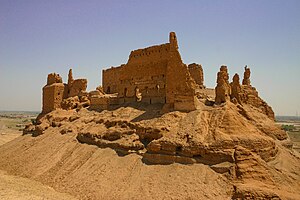Qalʿat ar-Rahba
| Qalʿat ar-Rahba | ||
|---|---|---|
|
Qalʿat Rahba |
||
| Creation time : | before 1105 | |
| Castle type : | Hilltop castle | |
| Conservation status: | ruin | |
| Place: | al-Mayadin | |
| Geographical location | 35 ° 0 '17.9 " N , 40 ° 25' 23.6" E | |
| Height: | 220 m | |
|
|
||
Qalʿat ar-Rahba ( Arabic قلعة الرحبة, DMG Qalʿat ar-Raḥba ) was a castle near the Syrian city of al-Mayadin on the Euphrates .
investment
The facility is located on an isolated rocky knoll on the eastern edge of the desert. It is surrounded by a deep moat and essentially consists of two pentagonal walls reinforced with rectangular towers and a pentagonal donjon . Walls and towers are made of basalt ashlars, inside the castle the brickwork sometimes bears geometric ornamentation of Mesopotamian and Persian tradition.
history
Presumably there was a fortification here as early as the Abbasid period in the 10th century. After the death of the Grand Seljuq sultan Malik-Shah I in 1092, his brother Tutusch I had himself proclaimed sultan in the Qalʿat ar-Rahba in 1093 and asserted himself as ruler of Syria.
In 1103 the castle came into the possession of Tutusch's son Duqaq through an exchange . It is mentioned in 1105 when Duqaq's brother Artasch, the only 12-year-old pretender to the throne of Damascus , fled Damascus here after the defeat of the Muslims in the third battle of Ramla .
In 1117 the castle was owned by Aq Sunqur al-Bursuqi , the Atabeg of Mosul . After 1128 it came under the control of the Zengids . Nur ad-Din (r. 1146–1174) had the apparently severely damaged facility completely rebuilt, and an uncle Nur ad-Din oversaw the construction work.
The Mamluk sultan Baibars I used the castle in the 13th century as an important base in defending against the Mongolian Ilkhan . In 1267 it withstood a siege by the Mongols.
The Qalʿat ar-Rahba, like the Qalʿat Jaʿbar , did not withstand the incursions of the Mongolian Timurids and was finally given up around 1401. The ruins, which were impressive at the time, have been preserved.
Individual evidence
- ↑ Georg Gerster, Ralf-B. Wartke: Aerial images from Syria. From ancient to modern. Zabern, 2003, ISBN 3-8053-3249-1 , p. 168 f.
- ↑ Michael A. Köhler: Alliances and treaties between Frankish and Islamic rulers in the Middle East. De Gruyter, Berlin 1991, ISBN 3-11-011959-5 , p. 13.
- ↑ Michael A. Köhler: Alliances and treaties between Frankish and Islamic rulers in the Middle East. De Gruyter, Berlin 1991, ISBN 3-11-011959-5 , p. 89.
- ↑ Steven Runciman: History of the Crusades. CH Beck, Munich 2001, ISBN 3-406-39960-6 , p. 400.
- ↑ Michael A. Köhler: Alliances and treaties between Frankish and Islamic rulers in the Middle East. De Gruyter, Berlin 1991, ISBN 3-11-011959-5 , p. 107.
- ↑ Steven Runciman: History of the Crusades. CH Beck, Munich 2001, ISBN 3-406-39960-6 , p. 441.
- ↑ Michael A. Köhler: Alliances and treaties between Frankish and Islamic rulers in the Middle East. De Gruyter, Berlin 1991, ISBN 3-11-011959-5 , p. 130.

